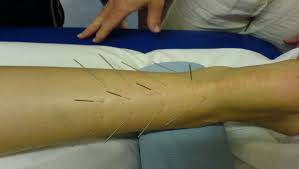Acupuncture for Achilles tendinopathy
Achilles problems are quite common, De Jonge (2011) found
that the annual incidence of Achilles tendinopathy is 2.01 per 1000 people.
In runners the incidence ranges from 9.1% to 10.9% (Lopes et
al 2012).
Achilles ruptures typically occur in males in their 30's and
40's who play sport intermittently (Khan & Carey Smith 2010).
Now we already know that Achilles tendinopathy needs to be
treated with exercise based therapy and the evidence highlights that this is
the most effective approach. However we always need a plan B just in case Plan
A doesn’t really work or is difficult to achieve for whatever reason.
To see the usual care for Achilles tendinopathy click here:
So what acupuncture points are regularly used for Achilles tendinopathy?
Local points:
Increased collagen synthesis and reorganisation requires
that at least one acupoint is anatomically connected with the site of the
injury because of the local tenoblast mechanotransduction mechanism (de Almeida
et al 2013).
The most common application of local points is the herringbone
technique using 9-12 needles (Kishmishian et al 2012). (see below picture).
Trigger points:
Often the calf muscles can be in spasm, therefore needles
inserted into the trigger points in the calf can be of use. (see pictures below).
So now we know what points can and are used, but does it work?
Now there is always a lot of debate in the Physio world
regarding acupuncture so we will try to look at this through the evidence and
try to sum things up overall.
For acupuncture:
Acupuncture is effective for the treatment of chronic pain
and is therefore a reasonable referral option. Significant differences between
true and sham acupuncture indicate that acupuncture is more than a placebo
(Vickers et al 2012).
Results suggest that acupuncture is effective for some but
not all types of pain. (Lee & Ernst 2011).
Acupuncture can improve pain & activity in patients with
chronic Achilles tendinopathy compared with eccentric exercises (Zhang et al
2013).
Acupuncture may have a role in the treatment of
tendinopathy, through the facilitation of tendon blood flow and fibroblastic
activity (Neal & Longbottom 2012).
Acupuncture combined with eccentric calf muscle loading may
be effective in the management of Achilles tendinopathy (Sokunbi 2014).
Against acupuncture:
The National Institute of Heath and Care Excellence
(N.I.C.E.) says this about Acupuncture:
“Acupuncture is sometimes used (but there is no evidence on
its use in Achilles tendinopathy)”
These guidelines were written in 2010 and haven’t been
updated as of yet so there opinion may change but currently this is their
stance on acupuncture for Achilles tendinopathy.
One of the main arguments against acupuncture is that it is
simply just a placebo. The trouble with this argument is that if they are
correct and the effect is placebo then is this wrong? I suggest that you read
my article on placebo effect here:
Interesting points in the above article are here:
“Linde et al (2007) found a significant association between
better improvement and higher outcome expectations with placebo treatments.”
Also here:
“Kaptchuk et al (2008) actually found that patients did
better if the practitioner was caring, warm, attentive and confident even when
they offered the exact same placebo treatment.”
So if this is true of placebo then why did Macpherson et al
(2013) find little evidence showing that different characteristics of
acupuncture/acupuncturists modified the treatment effect?
“Not all placebo effects are created equal:
The reality is that not all placebo effects are equal and in
fact, it is likely that a treatment considered to be no better than its placebo
version may still be more effective overall than a treatment that is considered
better than its placebo counterpart. So what are we to do in this case? Do we
use the lesser effective treatment that is not just a placebo or do we choose
the treatment that is essentially a placebo but is actually more effective? I
know what I would choose as a patient but it’s different as the practitioner.”
Interestingly Macpherson et al (2013) also found that if you
used more needles & had more sessions of acupuncture then the difference is
greater when comparing acupuncture to non-acupuncture controls (Macpherson et
al 2013). So maybe the issue about some research is not specific to acupuncture
versus sham but how to apply acupuncture optimally to achieve a clinically
significant result.
Maybe we should look at what the exact parameters of
acupuncture treatment should be, then use this, to compare to sham. After all
if I had a chest infection and took 1 antibiotic per week it would be no better
than a placebo but if I took the correct dosage then it would be effective. In
fact this study looking at randomised controlled trials found that only 25% of
them actually performed the acupuncture as it should be performed according to
Chinese textbook acupuncture standards (Molsberger et al 2011).
Overall as a plan B or C, acupuncture can be effective
alongside the normal exercise based management so it is worth considering as a
treatment option for Achilles tendinopathy. I have certainly found it to be
effective for particular patients.







Comments
Post a Comment